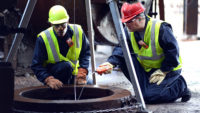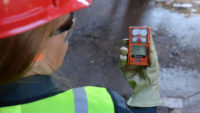As any safety manager or industrial hygienist knows, nothing is more important than worker safety. Businesses have been working to protect employees at risk of exposure to hazardous gases for generations. Today, however, facilities can transform their safety practices by adopting a platform approach, which connects gas detectors and key situational information to cloud-based analytics and applications.
With a platform approach, you can dramatically improve the effectiveness of your safety program by reducing the time spent on basic maintenance and compliance tasks so you can focus on the big picture. It can also help increase team efficiency and productivity, as well as help teams identify trends and patterns in safety incidents to stop trouble before it starts.
Components of a platform approach
Before you can get started with a platform approach for your gas detection program, you need the right hardware for the job. Investing in personal and area monitoring equipment that can connect anywhere, anytime without IT setup is ideal.
And with connection options like cellular, wi-fi, satellite, mesh networks, and many more, you can make sure the entire team knows who is in danger and why by automatically sharing real-time gas readings, man-down, and panic alarms between peers.
Once you have monitors that connect to the cloud and to other nearby personal and area monitors, you need the technology tools to make use of the information at your fingertips. A complete software suite will bring together device management data, real-time hazard data, and maximum visibility and control into your site.
One component of that, for example, should provide visibility into each person’s monitor from a single dashboard – whether through built-in connectivity or via connected docking stations – to simplify the management of hazards, people, and equipment.
Because you have visibility into each monitor on your site, you can also see exactly when alarms occurred, how long they were in alarm, and ensure that each issue is addressed quickly, safely, and effectively. With bump tests and calibration trends at your fingertips, you can also quickly find what you need to simplify auditing and reporting procedures.
Worker safety also depends on how quickly you can respond to an emergency. With a live monitoring solution, you gain real-time visibility into worker and site conditions. Real-time text, email, or onscreen alerts about worker location and status enable you to respond when it matters, while a live map of worker locations and hazards help save time in emergencies.
Because it provides visibility across all devices and locations, live monitoring solutions also make it possible to identify high-risk areas with visual summaries of gas alarms by type, location, user, and more. Top-quality software tracks devices to significantly reduce lost hardware at your site. From the worker’s perspective, however, live monitoring eliminates manual check-ins so they can focus on the job and know that someone will respond if they need help.
Meanwhile, if a chemical release happens, having the right tools and insights can make all the difference. With dynamic plume modeling software, you can get real-time, predictive information that enables proactive response during a chemical event. It enables you to immediately identify the source of a chemical leak so you can stop it quickly, pinpointing danger zones on a map that combine real-time data from gas sensors, weather stations, and local traffic patterns.
Additionally, once integrated with on-site gas detectors and weather stations, dynamic plume modeling software can run models before a shutdown or other event, showing you where to set equipment, which high-risk areas need extra precautions, how to train your teams, and more. This crucial data ensures everyone is well prepared to execute plan A, B, or C depending on the emergency.
Your team can also work more efficiently by automating post-event analysis and odor complaint processes. With the resulting data, you can make strategic improvements to safety protocols, helping reduce the impact of future incidents.
Individually or together, these solutions help you advance safety, streamline operations, and build a strong strategy for continuous improvement.
Headache-free maintenance
Proper maintenance ensures that devices are ready to always keep workers safe. Failures in the equipment room are inconvenient, and failures in the field can be deadly.
However, traditional approaches to gas detector calibration, maintenance, and repair tend to be hands on and labor intensive. You may need to purchase and maintain multiple extra units to prevent work slowdowns when detectors are out of service, in addition to an inventory of tools and parts. Record keeping using paper forms or spreadsheets is prone to errors — something you can’t afford when safety is on the line.
Choosing reliable equipment helps reduce maintenance issues. But it’s only the beginning. By investing in a platform approach, you can dramatically reduce maintenance, increase visibility, improve safety, and enhance the productivity of your team.
One way to streamline gas detector maintenance is by choosing a connected docking station. This can provide automated gas detector charging, bump tests, calibrations, record storage, and fleet management, with flexible data access options for your business needs.
To take maintenance maturity to the next level, you can add a comprehensive subscription service to your platform approach that covers gas detector maintenance and repair, shipping, calibration gas, docking stations, training, and more.
A subscription service automatically replaces your gas detectors when, and often before, failure occurs. By eliminating maintenance and repairs from your to-do list, your team gains time to focus on broader improvements to your safety program and workers can focus on getting the job done – knowing that their gas monitor is ready to alert them to potential hazards.
Protecting worker health and safety
By using a platform approach to safety, whether in whole or in part, you can streamline operations, ensure device readiness, enhance visibility into worker and site conditions, respond faster during emergencies, and more — all while protecting worker health and safety.
Whether you want to improve hardware reliability, consolidate monitoring and management, or optimize overall safety operations, a platform approach can give you the tools you need. You can adopt the elements that make sense for your business today and grow into more advanced capabilities at your own pace.



